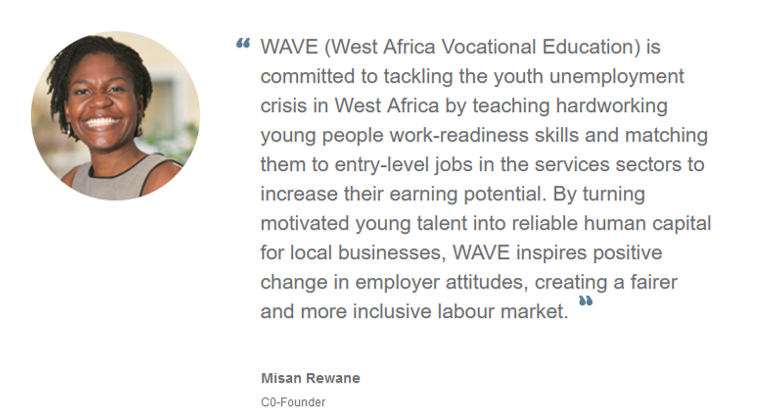WAVE describes the high youth unemployment rate in West Africa and the insufficient preparation of youth (16 – 30 years old) in schools and universities to participate and compete in the job market as the core motivation for starting the organization.

Our Approach
WAVE applies an integrated approach for bringing unemployed youth into jobs. Before being admitted to WAVE, applicants are screened for determination and willingness to learn. The participants of WAVE then undergo short-course training focusing on personal employability skills such as effective communication, time management, problem solving, managing expectations and critical thinking. After completion of the training, the alumni are matched with jobs through a network of employer partners.
WAVE is organized as a not-for-profit social enterprise. The enterprise is based on a two-sided business model that aims to share the cost of training between trainees and employers, increasing the financial sustainability of the academies.
Specific Activities
- Media campaigns and cooperation with government institutions to find applicants for WAVE’s academies
- Thorough screening process, identifying the most promising individuals for admission
- Provision of short-courses (on average 3 weeks duration) for teaching personal skills required by employers, e.g. communications and customer relations
- Matching of WAVE alumni with available jobs in employer network
- Provision of post-training support through workshops and mentoring
- Ongoing development of a soft-skills assessment tool that will measure WAVE alumni/job candidates’ proficiency in core employability skills
Key Results
- 3000+ youth trained in 2019 with an average total cost per trainee of 666 USD
- One year after training, 58% of alumni are in employment, 14% are self-employed, 8% are continuing their education and 20% are still unemployed
- Three years post-train
- Network of 500+ employer partners built
Lessons Learnt (Success Factors & Challenges)
- Partner with local leaders to leverage their networks and credibility in new communities. This saves cost and time when creating awareness about the program as we expand
- Selection based on attitude rather than skills, experience or credentials: screening IN based on determination and willingness to learn levels the playing field for young people from the most underserved communities
- Experiential learning is key when it comes to instilling lessons in a short period of time. We find that it is far more effective to show students what the world of work is like, and to give them first hand, monitored experience, than it is to tell them about it. This is why we have a week of unpaid internship built into our curriculum
- Successful job matching is as much about coaching as it is about finding the right fit on the job. We work to coach employers to invest in training and supporting their staff. We work to coach youth in sticking it out on a difficult job. This improves retention rates.
Which elements/tools are most suitable for replication / scalability?
- Principle: Screening in for attitude and training for skills by using an objective, practical method of identifying youth who are motivated and determined to take advantage of training and matching programs
- Product: WAVE Soft skills curriculum and instructional design (effective communication, problem solving, time management, expectations management, teamwork, selling)
- Principle: Demand-driven training that responds/links to the needs of the employment market thereby increasing employability / earning potential


